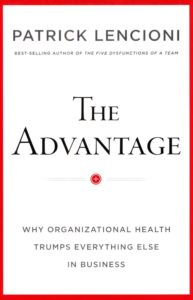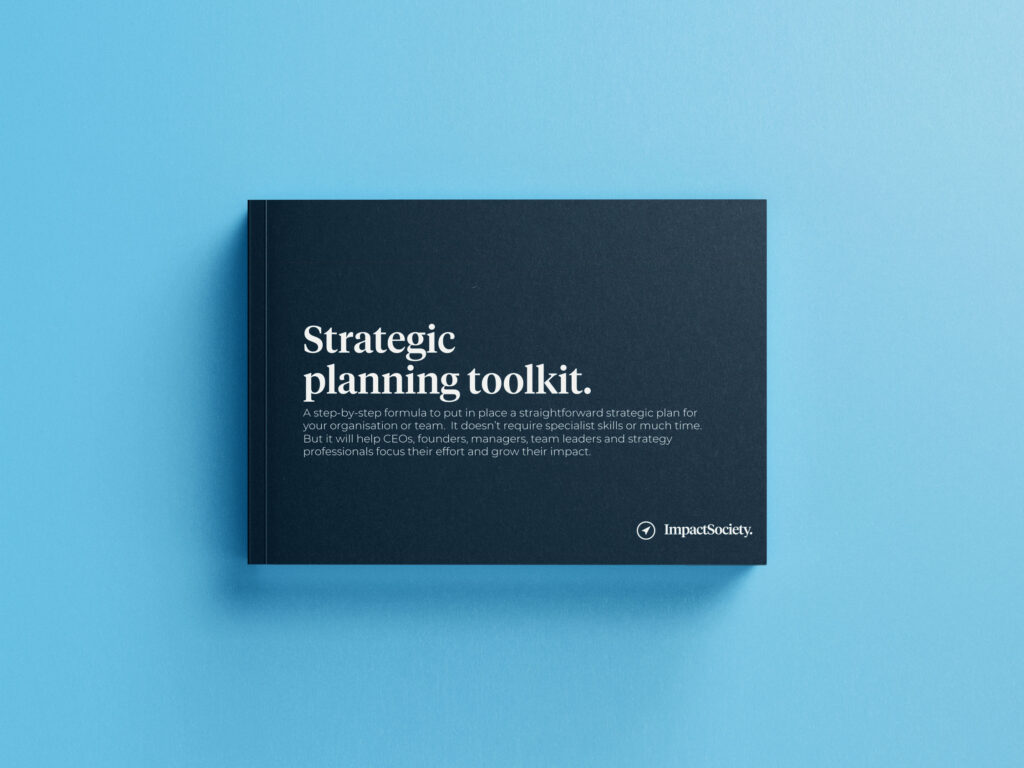
The book in a paragraph
The strongest organisations are those that are healthy, not just smart. Organisational health depends on four disciplines: developing a cohesive leadership team, creating strategic clarity, over-communicating that clarity throughout the organisation, and reinforcing strategy through systems and ways of working. Clarity doesn’t need to be complex and abstract, instead it can be achieved by answering six questions for any organisation: Why do we exist? How will we succeed? What do we do? Who does what? What’s most important, right now? How will we behave?
Summary of The Advantage by Patrick Lencioni
This is my summary of The Advantage by Patrick Lencioni. These notes are informal and may contain quotes from the book, mixed with my own thoughts.
An organisation has integrity – is healthy – when it is whole, consistent and complete, that is, when its management, operations, strategy and culture fit together and make sense
Patrick Lencioni
- Smart organisations have strong strategy, marketing, finances, technology etc.
- Healthy organisations out-compete smart organisations (but of course it is best to be both healthy and smart).
- Organisational health is undervalued by leaders who mistakenly write it off as unsophisticated, a ‘nice to have’ and/or not easily quantifiable.
- There are four disciplines that leaders must adopt to create a healthy organisation.
- Discipline 1: Build a cohesive leadership team that overcomes the five dysfunctions of a team.
- Dysfunction 1: Absence of trust. Teams must have high levels of vulnerability-based trust where people are completely comfortable being transparent and honest with one another, and prepared to sacrifice their egos for the good of the team.
- Dysfunction 2: Fear of conflict. Teams that trust one another can focus on mastering constructive conflict in the pursuit of truth, to discover what’s best for the team.
- Dysfunction 3: Lack of commitment. Teams that master conflict can commit to team decisions: “if people don’t weigh in, they won’t buy in”, so teams must “disagree and commit”.
- Dysfunction 4: Avoidance of accountability. With high levels of commitment, team members can hold one another accountable and eliminate the possibility of people saying “I never agreed to that in the first place”.
- Dysfunction 5: Inattention to results. Attention to team success, not individual goals and personal status, is only possible with high levels of commitment.
- Discipline 2: Create organisational clarity by answering six questions (we go into these in detail in our article on the six questions that every high performing organisation must answer).
- Why do we exist? This defines an organisation’s core purpose or reason for being.
- How will we succeed? This identifies strategies for success that an organisation will follow, to deliver on its core purpose.
- What do we do? A straight forward list of key activities.
- What’s most important, right now? Identify a single, temporary thematic goal (e.g. introduce three new products by the end of the year) that is then translated into a set of supporting objectives (e.g. complete market testing, recruit new product teams, complete product design, redesign production processes etc.). A set of standard operating objectives is also developed to articulate important ongoing metrics (e.g. revenue, expenditure, employee engagement, customer satisfaction etc.)
- Who must do what? Define clear roles and responsibilities for each member of the leadership team.
- How do we behave? Identify an organisation’s values that define how it must behave to succeed.
- Discipline 3: Align the organisation by over-communicating the answers to each of the six questions. Employees need to hear the messages over and over (up to seven times is a good benchmark) before they understand and believe what leaders are saying.
- Discipline 4: Reinforce clarity by aligning systems of recruitment and onboarding, performance management, reward and recognition, and letting people go with organisational values and priorities.
- Meetings in most organisations are inefficient because of ‘meeting stew’, which confuses tactical and strategic items in the one meeting.
- The answer is to introduce four types of meetings.
- Daily check in: A 10 min stand up meeting to discuss administrative issues and hence minimise e-mail traffic, phone calls and hallway conversations.
- Weekly tactical: A 45 to 90 minute meeting to review progress against an organisation’s priorities (as defined by the goals and objectives developed in answer to the question, ‘What’s most important, right now?’) and discuss relevant issues.
- Ad hoc topical: This sets aside two to four hours, scheduled as required, to dig into critical issues that can have a long-term impact or require significant time and energy.
- Quarterly off site: A one or two day meeting for a team to step back from the business and get perspective, looking at things such as reviewing the thematic goal, key employee performance, industry trends and competitive threats, and reviewing the cohesiveness of the leadership team itself.
Impact Society
Strategic Planning Toolkit
NEW
Launch a straightforward strategic plan in under 30 days. A step-by-step guide for that includes a 130+ page guidebook and templates, checklists and agendas.
Where to go next
- Download our free Team Alignment Canvas, which provides a simple way to capture your answers to each of the six questions
- Read our summary of The Five Dysfunctions of a Team by Patrick Lencioni
- Read our article on the six questions that every team and organisation must answer
- Watch a video on organisational health by the author Patrick Lencioni
- Buy a copy of The Advantage: AU • UK •US




